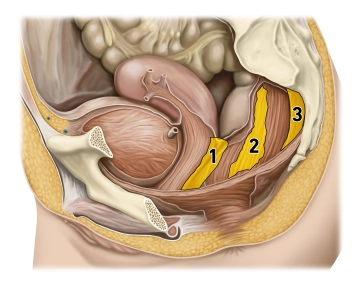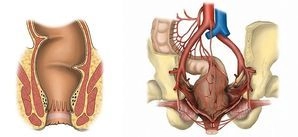Rectum
From a functional point of view, the rectum is a storage reservoir for feces preventing its continuous discharge. The rectum directly adjoins the sigmoid colon and resembles it in that it has an S-shaped anteroposterior and lateral curvature (sacral, anorectal and sacral flexure). Typically, the rectum is divided into three segments:
1. Rectal ampulla (main reservoir, anterior to the sacrum)
2. Anal canal (see below, sealing zone between the anorectal flexure and the cutaneous orifice)
Between 1. and 2. an unspecified section which emerges perpendicularly from 1. and joins 2., also at right angles. Here, the mucosa presents with typical folds (Kohlrausch's folds).
Posteriorly the rectum is related to the sacrum and coccyx, laterally to the internal iliac arteries and veins, regional lymph nodes, sacral plexus and parts of the autonomic nervous system, as well as both ureters and uterine adnexa. In the female, the uterus and vagina lie anteriorly, while in men this is true for the bladder and prostate/seminal vesicles. Inferiorly the rectum is related to the pelvic floor.
Blood supply
Three main arteries supply the rectum with blood:
- Superior rectal artery (from the inferior mesenteric artery) via the sigmoid mesocolon (Caution: Transection of this artery at the level of the sigmoid colon results in ischemia of the upper rectum!)
- Medial rectal artery (from the internal iliac artery), coursing craniad of the levator ani
- Inferior rectal artery (from the internal pudendal artery) inferior to the levator ani.
Venous drainage is via the venous rectal plexus underneath the mucosa of the rectum. The superior rectal vein drains the blood of the upper rectum via the inferior mesenteric vein into the liver, while the medial and inferior rectal veins drain the blood of the middle and lower rectum via the internal iliac vein into the lower vena cava (portocaval anastomosis). Medications administered as suppositories therefore only enter the body without being metabolized, if they are not advanced up into the region drained by the superior rectal vein.
Lymphatic drainage of the rectum parallels the rectal blood vessels: The large cluster of inferior mesenteric lymph nodes forms a separate group at the upper rectum (superior rectal lymph nodes); the internal iliac lymph nodes filter lymph from the middle rectum (from the pararectal lymph nodes) and the superficial inguinal lymph nodes from the lower anal region, anus and perineal skin.

